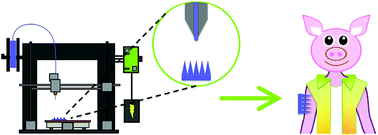Biodegradable 3D printed polymer microneedles for transdermal drug delivery†
Abstract
Biodegradable polymer microneedle (MN) arrays are an emerging class of transdermal drug delivery devices that promise a painless and sanitary alternative to syringes; however, prototyping bespoke needle architectures is expensive and requires production of new master templates. Here, we present a new microfabrication technique for MNs using fused deposition modeling (FDM) 3D printing using polylactic acid, an FDA approved, renewable, biodegradable, thermoplastic material. We show how this natural degradability can be exploited to overcome a key challenge of FDM 3D printing, in particular the low resolution of these printers. We improved the feature size of the printed parts significantly by developing a post fabrication chemical etching protocol, which allowed us to access tip sizes as small as 1 μm. With 3D modeling software, various MN shapes were designed and printed rapidly with custom needle density, length, and shape. Scanning electron microscopy confirmed that our method resulted in needle tip sizes in the range of 1–55 μm, which could successfully penetrate and break off into porcine skin. We have also shown that these MNs have comparable mechanical strengths to currently fabricated MNs and we further demonstrated how the swellability of PLA can be exploited to load small molecule drugs and how its degradability in skin can release those small molecules over time.



 Please wait while we load your content...
Please wait while we load your content...
